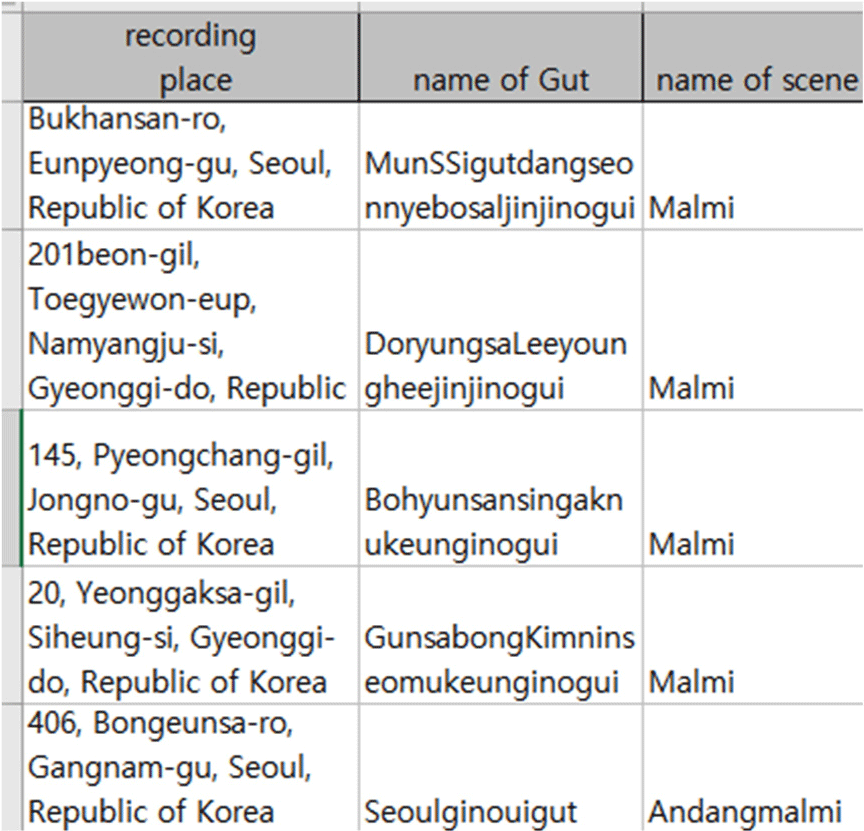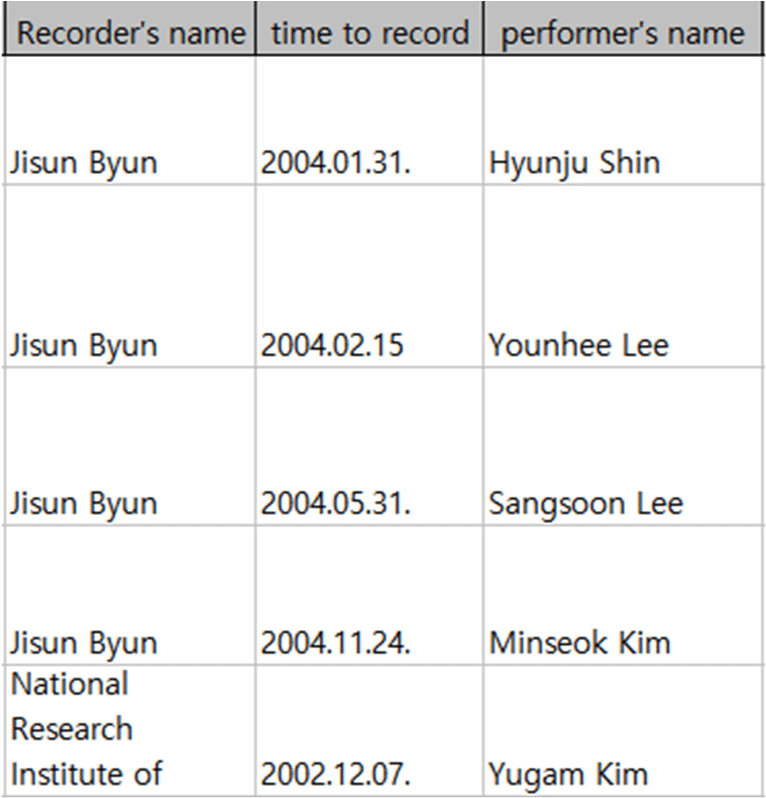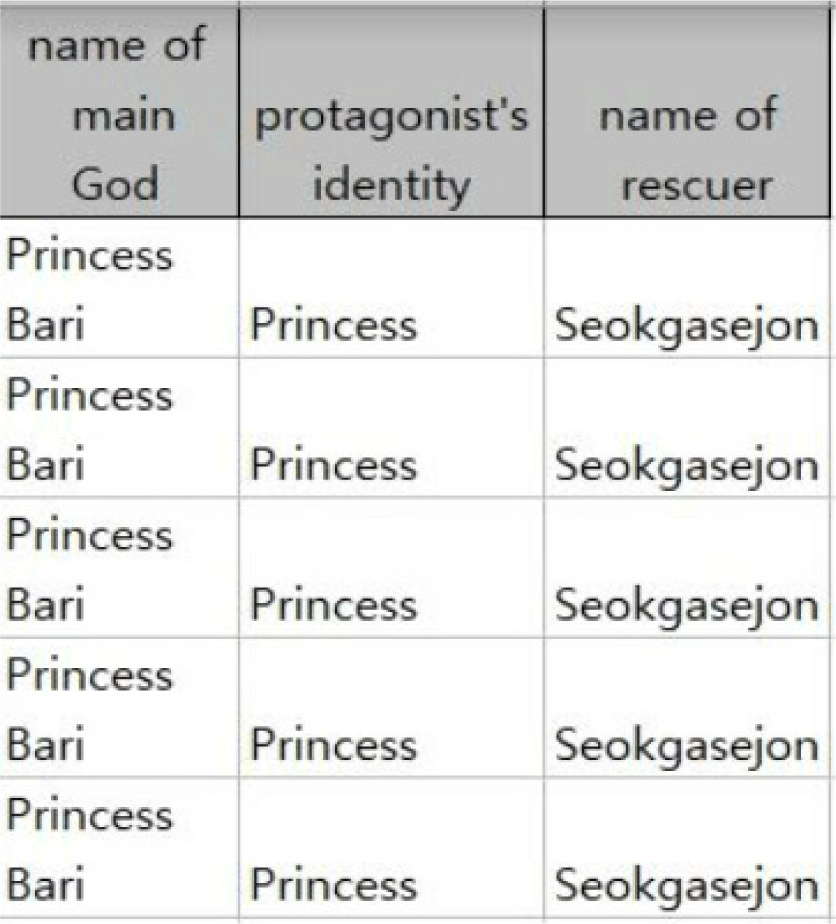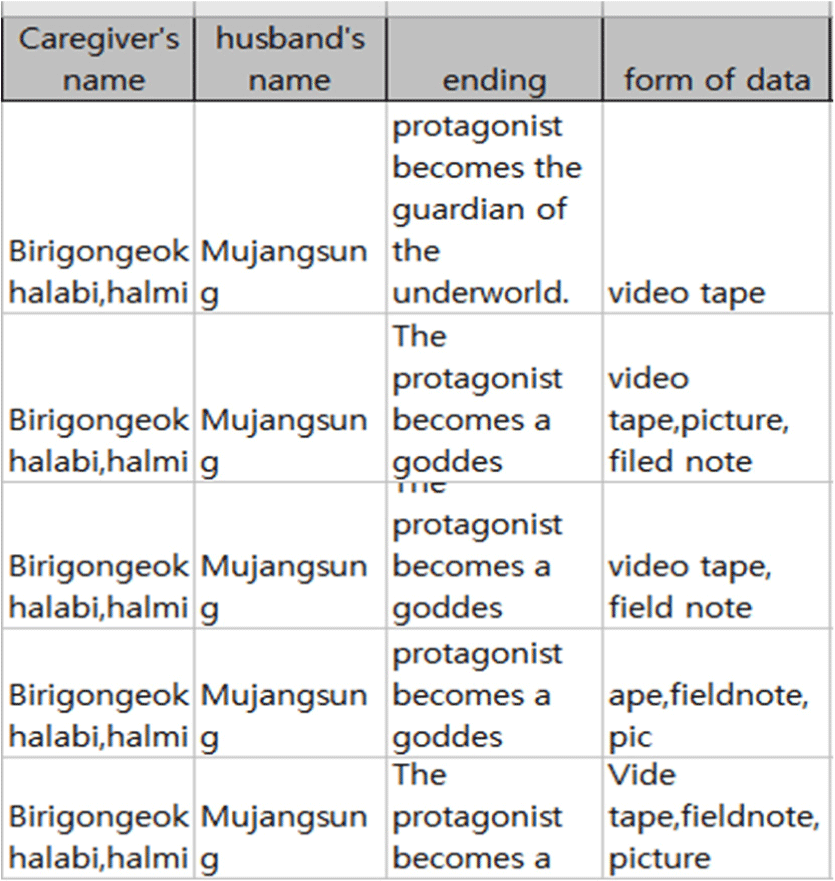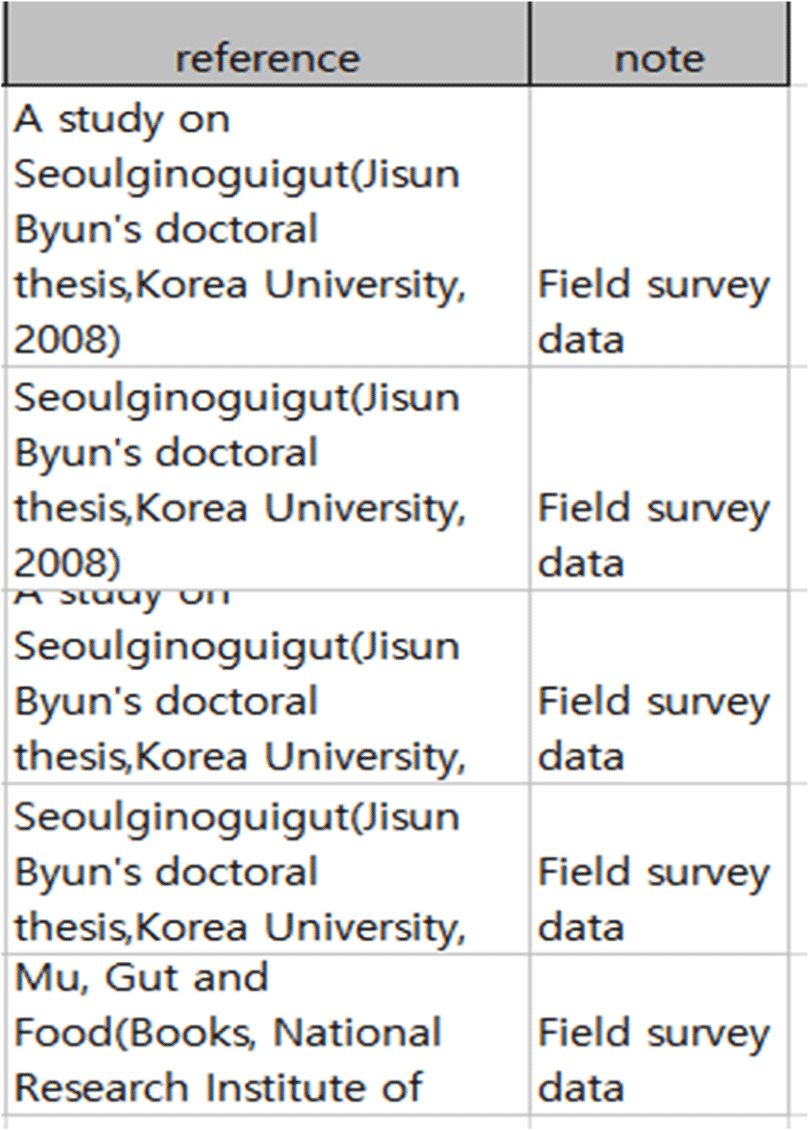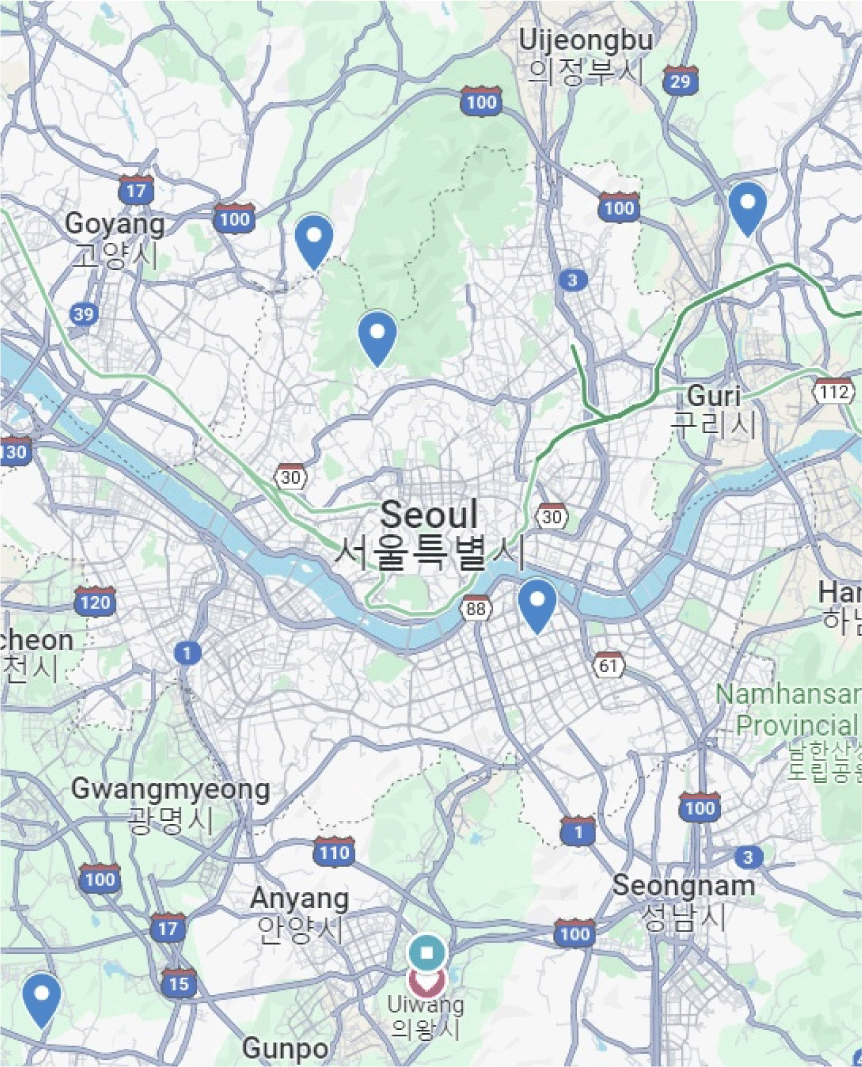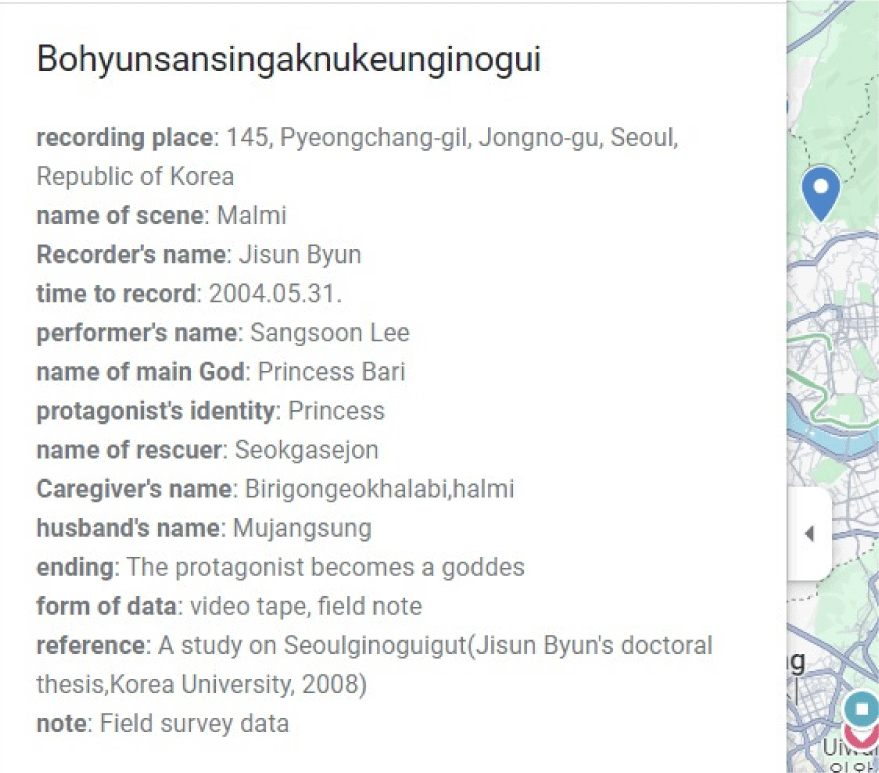I. INTRODUCTION
The purpose of this study is a preliminary study to develop an Electronic Cultural Atlas of Korean mythology. To achieve this purpose, we will conduct research on <Princess Bari>, a Korean shaman myth. Electronic Culture Map is a large-scale database based on three axes: time, space, and topic.
The purpose of this study is to create an Electronic Cultural Atlas of Korean mythology. For this purpose, we will create an Electronic Cultural Atlas based on the Korean myth of <Princess Bari>.
In Korean literature, studies have been conducted to develop Electronic Cultural Atlas for tales, folk songs, and Gasa (A type of traditional Korean poetry). However, no Electronic Cultural Atlas has been developed for Korean mythology. However, an Electronic Cultural Atlas of Korean mythology has not yet been developed.
In this study, we will conduct preliminary research to create an Electronic Cultural Atlas of Korean mythology. We will build a database targeting Korean mythology and use the built database to implement an Electronic Cultural Atlas on Google Maps.
Among Korean myths, <Princess Bari> is a shamanic myth told throughout the Korean Peninsula except for Jeju Island. The myth tells the story of Princess Bari, the heroine of the myth, who risks her life to obtain medicinal water to save her parents who abandoned her, and when she gets the water, she saves her parents and becomes the Goddess of guide for the dead. Depending on the shamanic ritual, the Goddess of the dead is called ‘Jinogi’ ‘Jinogigut’ ‘Jinjiogi’ ‘Saenam’ or ‘Ogugi’ among other names. <Princess Bari> was the first Korean shamanic myth to be investigated and documented by Akihaba Takasi and Akamatsu Chijo during the Japanese occupation [1]. In recognition of the artistry of <Princess Bari>, the government has designated ‘Seoul Saenamgut’, where <Princess Bari> is performed, as National Intangible Cultural Heritage No. 104 and protects it [2].
The sequence and methodology of the research is as follows. We will select a tool for mapping the <Princess Bari> database created by Jisun Byun [17]. Next, we will perform preprocessing to Atlas the <Princess Bari> database to an appropriate Electronic Cultural Atlas. Based on this, we will implement the <Princess Bari> electronic cultural Atlas.
II. RELATED RESEARCH
The research related to this thesis can be divided into two main categories. They are studies on the development of Electronic Cultural Atlass and studies on <Princess Bari>. For the research on the development of Electronic Cultural Atlass, will cite the most recent research on the development of Electronic Cultural Atlass, which is summarized in Jisun Byun ‘s paper [3].
The parent organization for the development of electronic cultural maps is the Electronic Cultural Atlas Initiative (ECAI). Research and development of Electronic Cultural Atlass began in the 1990s, centered on the University of California, Berkeley [4].
Heung-kyu Kim was awarded a research project on Electronic Cultural Atlass in the Joseon Dynasty by the National Research Foundation of Korea, and developed an Electronic Cultural Atlas system for the Joseon Dynasty and presented the humanistic meaning and prospects of Electronic Cultural Atlass in the Joseon Dynasty.
His research on Electronic Cultural Atlass in the field of Korean literature is as follows. Hyung-dae Lee presented the construction and utilization of an Electronic Cultural Atlas based on traveling Gasa (Korean tradinational poet). Soon-cheol Baek discussed the academic utility and significance of digital archives for database construction and made to Electronic Cultural Atlas of invisible folk materials such as folk songs, focusing on the distribution of domestic work songs. Jisun Byun proposed an Electronic Cultural Atlas of Seoul’s village guts, including video, image, and sound information. In order to record and map dynamic Seoul-area village Guts (shamanic ritul) on an Electronic Cultural Atlas, he developed a system to search for videos, images, and music, complementing the Joseon Dynasty Electronic Cultural Atlas system. Chunho Shin presented a proposal to build an Electronic Cultural Atlas of meandering routes in pre-modern meander-related geospatial areas. Seungjun Yoon proposed a methodology for drawing a map of Korean folk tales, which includes: (1) collecting primary data, (2) exploring oikotypes by type and motif through a review of regional distribution and variation, (3) establishing folk tale regions based on oikotypes, (4) building a database for creating folk tale maps, and (5) building a WEB system for database services.
Seung-jun Yoon’s map of narrative literature is based on the regions where the stories are transmitted, such as Buyeo city and Gongju city. In contrast, this researcher intends to create a map that considers more precise locations on the map. This is because the location of Korean myths is very important. For example, Gaksadang (Performance place) is located on Inwang Mountain in Seoul. It has historical significance because it has been a place of worship since the Joseon Dynasty. In addition, Seung-jun Yoon ‘s map of narrative literature uses the concept of ‘motive’, but the map this researcher intends to produce is different in that it includes ‘motive’ as a subset of mythological content and attempts to show the entrapment aspect in an Electronic Cultural Atlas.
Dong-ho Jang and Sang-in Cha built an Electronic Cultural Atlas database and mapped the folk song ‘Nonmae-gi Sound’ in both preliminary and practical fields. They analyzed the musical features, social and cultural functions, and geographical climate of ‘Nonmae-gi Sori’ to create a database, built a website based on the Electronic Cultural Atlas, and proposed ways to use it.
Jihoon Kang proposed a model of a knowledge map that complements the existing Electronic Cultural Atlas, and Sangho Moon compared the existing Electronic Cultural Atlass.
The Korea Institute of National Studies has developed a Confucian cultural Atlas [25]. In this map, local Confucian sites and local figures related to Confucianism in the Gyeongsangbuk-do region were DB and implemented as an electronic Atlas using Adobe flash player.
Currently, the Confucian Cultural Atlas is based on adobe flash player, which has the disadvantage of being unavailable to general users after 2021. However, if you use a browser other than Internet explorer and Google Chrome and the appropriate version of adobe flash player, you can use the Confucian Cultural Atlas service.
Confucian Net’s Confucian Culture Map is a map developed by a large number of people over a long period of time based on the vast amount of Confucian materials accumulated over the years and considering how to provide services on the web. Confucianism in Korea can be traced back to 372 AD, when Goguryeo’s Taehak was founded, so it can be said that Confucianism has existed and data has been generated for a long time until now. Therefore, it can be said that Confucianism is a religion that can be realized as an Electronic Cultural Atlas consisting of a time axis, a space axis, and a theme axis. Nevertheless, the time axis is not clear in Confucian Cultural Atlas. Since the Atlas is intended for the general public, this type of Atlas can be considered a service.
Jiang Woo of Arizona State University has discussed the difficulty of quantifying and mapping the movements of specific figures in Buddhism and the relationships between them. For important figures in the religion, such as founders and key figures, it may be necessary to mark their movements and relationships with other figures throughout their lives [26].
In the Confucian Cultural Map, the information in the life story of Emperor Hwang Yi is presented through illustrations. ‘Hakmakdo’ is the means of expression. It has the advantage of visualizing the long and complex relationships between Hwang Yi’s characters in a single picture. However, the Confucian Cultural Atlas does not provide information on the movement of each person’s residence or relationship with other people. In this case, we could have used an ontology to contextualize the information, but ontologies are a more complex tool, so we will present a simpler solution in this article.
A genealogy is a way to represent the relationships a person has had over their lifetime, or a family’s lineage over several generations. A genealogy is a tree-like representation of family relationships, from ancestors to the present day. A family tree shows parentage, marriage, in-laws, and out-laws. The tree structure of a genealogy allows you to display relationships from the founder of a religion to the present day. If a genealogy is based on fathers and sons, in the case of a religion, you can draw a lineage from the founder to the head of the church. On the web, we could use hyperlinks to show how a person is related to other people.
By first visualizing and simplifying complex relationships between people, and then analyzing information about their relationships, places, buildings, landscapes, travel routes, and related materials, we can consider what information to provide to which users and choose the appropriate tools.
Wonkwang University’s Center for Mindfulness and Humanities mapped places related to mindfulness on Google Maps and provided information to users by linking to related information.
Jisun Byun explored the development of an Electronic Cultural Atlas of Daesoon Jinrihoe. He analyzed the aspects of electronic information provision of Daesoon Jinrihoe and suggested directions for the development of an Electronic Cultural Atlas.
There have been many studies on <Princess Bari>, starting with the investigation of Akamatsu Chijo and Akihaba Takasi in 1937 during the Japanese occupation. These discussions are well organized in the following four dissertations.
Tae-han Hong summarized more than 40 papers related to <Princess Bari> that have been studied so far, and summarized and compared 47 different versions of <Princess Bari> transmitted throughout the country. He also divided the nationwide versions of The <Princess Bari> into regions [5].
Jisun Byun studied the myths and rituals of the Seoul Jinnogigut and discussed the <Princess Bari> performed at the Seoul Jinnogwuigut as a myth. He analyzed the content of the shamanic myth <Princess Bari>, analyzed the performance patterns, and compared the <Princess Bari> with the <Jumong Myth>. He also summarized the data and research papers on <Princess Bari> investigated since 1937 [6].
Junseop Yoon examined the epigraphic and literary features of the Hamhung area’s version of the <Barydegi>. He reviewed the recorded and newly acquired materials, transcribed audio and video materials from the newly acquired materials, compared them with the previously recorded version of the Hamhung area’s version, and corrected errors in the earlier version [7].
For the Seoul area’s version of <Princess Bari>, Bo-yoon Cho first elucidated how Buddhist temples and shamanic temples were combined, and finally derived a deeper principle of combination that operates in the process of combining Buddhist and shamanic temples [8].
BGIS was developed by the Center for Buddhist Studies at the University of Arizona, USA. Funding for the Buddhist Geographic Information System development project was provided and sponsored by the Office of the Vice Chancellor for Research at the University of Arizona from 2003 to 2004, with additional funding from the Henry Luce Foundation and cooperation from ECAI at the University of California, Berkeley. The Center for Buddhist Studies at the University of Arizona developed BGIS versions 1.0 and 1.1, which are posted on its website, and developed many unpublished datasets. The system aims to build a searchable relational database of Buddhist monasteries around the world using a tool called Geographic Information (GIS). Combining data science and electronic mapping, GIS software can integrate different types of information about Buddhist monasteries and visualize the information by displaying it on a map.
The database will allow researchers to study the geographical distribution of Buddhist spaces and Buddhist figures, the information of Buddhist pilgrimage networks and their relationship with other cultures and social institutions. The current project aims to develop a dataset of spatial information related to Buddhist capitals in China.
This BGIS is a Buddhist Electronic Cultural Atlas developed by limiting the scope of the vast religion of Buddhism to the region of China. It centers on geographic information about temples in China and provides quantitative information such as temple names, building types, and dates of construction. In addition, Jiang Wu, one of the developers of BGIS, has been working on building a database of the ‘concepts’ of various parts of religion. By showing the problems in the database design stage, which should be preceded by the development of an Electronic Cultural Atlas of religion, it can be said to present important points to be considered in the development of Electronic Cultural Atlass of other religions.
III. REVEWING TARGETED MATERIALS
<Princess Bari> is a myth about <Princess Bari>, the highest of the Korean Goddess and a guide to the dead. In traditional Korean culture, when a person dies, the bereaved family performs a good deed for the deceased. The purpose of this shaman ritual is to make sure that the deceased is comfortable and goes to a good place. The main character of the myth, <Princess Bari>, was born as a princess in the Joseon Dynasty, but she was abandoned by her father, the king. The reason for her abandonment was that she was not the crown prince. <Princess Bari> forgave her father for abandoning her. She then traveled to another world to fund a medicine for her reviving parents. On this journey, she encounters wandering spirits, and after nine years of labor, she gave birth to seven sons and obtains a potion and flowers, each of which cures flesh, blood, and breath. <Princess Bari> returned to this world to save her parents and refuses the price they offer her. She became a shamanic Goddess, a guide who takes the dead to a good place. In the good for the Dead, the living shaman performs the Good for the Dead on behalf of <Princess Bari> to send the Dead to a good place.
<Princess Bari> is practiced in all regions of Korea except Jeju Island. In particular, the meaning of <Princess Bari> in the Seoul area is special. During the Japanese occupation of Korea, Akiba Takasi and Akamas Chijo two scholars who worked for the Japanese Colonial Government of Korea, researched Korean shamanic myths. According to their research, <Princess Bari>, a song sung by a shaman named Kyungjae Bae in the Seoul area, contains the phrase ‘In the form of a shamanic ritual at Seonhee-gung’. Seonhee-gung was the alias of Yeongbin Lee, a concubine of King Yeongjo, and the name of her shrine. She gave birth to many daughters and one son. That son is the ‘Sadoseia. ‘Sadoseja’ was the crown prince and father of King Jeongjo who was imprisoned and starved to death in rice chest by his father, Yeongjo. Yongbin Lee was a member of the Joseon royal family, so <Princess Bari> sung by Kyungjae Bae represents his connection to the Joseon royal family. The lyrics of <Princess Bari> in the Seoul area include royal terms. There are few differences between versions of <Princess Bari> in the Seoul area. The shaman who sings <Princess Bari> in the Seoul area shaman ritual is dressed as a Joseon Dynasty princess and sings <Princess Bari>. In comparison, the lyrics of <Princess Bari> performed in Gangwon Province contain few royal terms. As such, <Princess Bari> varies by region, so if the <Princess Bari> passed down in all regions of Korea were displayed on an electronic cultural Atlas, it would be possible to visibly express the regional differences in <Princess Bari>.
There are three main types of data on <Princess Bari>: data recorded and saved as text and published as a book, data published as a book, and sound and video data on <Princess Bari>. In addition, there are materials that were published in books by organizing documents passed down from the mu system, but since these materials are not performance materials, they do not include the performers, places of recording, and the time of recording [20].
Among the materials that have been published as books after recording <Princess Bari> and saving it as a text, the first one to record the recording area, the date and time of recording, the lead singer, and the recorder is 『Research on Korean Shamanism』, written by Akiaba Takasi and Akamatsu chijo in 1937. It is a record of the oral history of Gyeongseong Shaman Baekjae. Although the date of the book is not precisely stated, it was published in 1937, so it is assumed that it was written in the 1930s and used as the best version of <Princess Bari>.
Later, Taegon Kim recorded four episodes of <Princess Bari> and published them in a book, and the date of recording, the recorder, the main singer, and the recording area are recorded in detail in this data [9].
The complete works of Taehan Hong’s “A research of Seosamuga <Princess Bari> have been published in volumes 1 through 4. This material is a combination of papers and documentation [10]. In addition, he recorded and published <Princess Bari> in the traditional Gut Nodule Festival Jinnogigut and Ganghwa Island as a book [11]. These materials record ‘investigators, participants, time periods, and regions’.
Kyungshin Park recorded <Princess Bari>, which was distributed on the east coast, and published it as a book. This document details the date of recording, place of recording, recorder, and performer [12].
Heonsun Kim recorded and published a book on Ananpyeonggut, Jinjinogigut, and Saenamgut in Seoul, and included <Princess Bari> in the book. The date of recording, recording area, recorder, and main carrier are indicated [13-14].
Kyungsoo Na recorded and published <Princess Bari> as a book in Ananpyeonggut, Guri, Gyeonggi-do, Korea. This document records the date of recording, the place of recording, the recorder, and the sender [15].
Jisun Byun organized more than 50 documents, including Research on Korean Shamanism, published by Akiba Takasi and Akamatsu Chijo [6]. She recorded the name of recording place, name of performer, name of Gut, and organized the data in the form of sound recordings (mp3 files), videos (mp4 files), and photographs (jpg files). Jisun Byun’s data does not contain the entire contents of <Princess Bari>, but excerpts of <Princess Bari> necessary for the thesis and the discriminatory arrest of Jin-ogigut in Seoul.
The data in Yoon’s master’s thesis reviewed and outlined the published recordings centered on the Hamheung version of <Princess Bari>, and transcribed the sound source of the video files of <Baridegi> (a version of <Princess Bari>, which was held in Mangmukgut (shaman ritual for the dead), Hamheung province. Yoon’s data includes the appearance, main performer, performer’s name and date of recording, but not the place of recording [7].
Boyoon Cho compiled 57 materials on <Princess Bari> in the Seoul area This material was compiled only for <Princess Bari> transmitted in the Seoul area, centering on already published book materials. His data is categorized by pseudonym, region, performer, place of presentation, publisher, researcher, and year of presentation. In Cho’s data, the regions are listed as ‘Seoul, Yangju, Incheon, Seongnam, Namyangju, Hanam, Ganghwa’, etc. Information on counties, districts, towns, villages, dongs, and regions is not included.
The National Institute of Cultural Heritage has published video and book materials on Seoul Sanamgut, National Intangible Cultural Heritage No. 104. These materials include video footage of <Princess Bari> being escorted at Seoul Sanamgut, and book materials include <Princess Bari> lyrics, escort patterns, new clothes, jewelry, and armor [2].
There are 10 episodes of <Princess Bari> available in the Korean Oral Literature System. This data contains the original text of <Princess Bari> that was orally recorded, and each data is categorized into folk song, shaman song, story, and other. For each material, the performer, recorder, and recorder are recording place [16].
The basic principle is to establish a field that can encompass the various layers of <Princess Bari> that have been recorded and published as books, and a field that can express the characteristics of the myth of <Princess Bari>.
IV. DECIDING ON THE RIGHT TOOL
The Electronic Cultural Atlas we are trying to implement in this study is not just a map. Strictly speaking, it is an atlas implemented on the web. The Joseon Electronic Cultural Atlas System of the Institute of Ethnocultural Studies at Korea University and BGIS at the University of Arizona used Micro Acess as a database tool and Arcmap to implement the map because Micro Acess can organize large amounts of data and attaching files. And Arcmap can connect various geographic information on a point-by-point basis.
However, Arcmap is not very accessible. It is important for laymen and mythologists alike to be able to understand the concept of layering and to be able to operate related programs. Therefore, the Electronic Cultural Atlas of <Princess Bari> should be easy to use for laymen and mythologists to get information about <Princess Bari> on the map.
Jisun Byeon’s <Princess Bari> database [17] is composed of fields including chronological and content elements of <Princess Bari>. Therefore, a tool that can reflect the characteristics of the <Princess Bari> DB is needed.
As a result of these considerations, we selected Google map as a tool that can realize an Electronic Cultural Atlas of <Princess Bari>. This is because Google map can map the information implemented in Micro Acess to Google map through preprocessing.
V. DATABASE PREPROCESSING
In order to convert the <Princess Bari> database to Google Maps, the process of converting the <Princess Bari> database to an Excel file is necessary. The result of this operation is shown Fig. 1.
In the Fig.1, the recording place, the name of Gut, and the name of the scene have been selected as fields for the different versions of <Princess Bari>. The corresponding fields are shown above. For the recording place, we entered the address of the administrative district. The name of Gut is the name of the recording place where the good is done and the name of performer. The name of the scene is like a chapter in a play. The above data is among the data recorded from 2002 to 2004, five pieces of data from the Seoul area were selected.
Convert the name of recorder, the date of record, and the name of performer from different versions of <Princess Bari> to Excel as shown Fig. 2. This gives us the names of performer who were active during this time. Yugam Kim is a master of ‘Seoul Saenam Gut’, Korea’s national intangible heritage. Thus, Yugam Kim’s <Princess Bari> can be seen as a canon.
As a result of our research, we found that the versions of <Princess Bari> passed down in the Seoul area are almost identical. What is different is the recording place, the recorder, the name of the Gut and the name of the performer. This suggests that the Seoul area’s Gut (shamanic ritual) are very fixed and rarely change. In addition, the places where Guts are taken are the city center of Seoul, a private shrine, and a specific place in the mountains.
In the next chapter, will implement the information recorded in the above Excel file into Google Maps.
In the Fig. 3, the name of the main deity, the identity of the protagonist, and the name of the rescuer are all the same.
In the Fig. 4, the name of the nurturer, the name of the husband, and the ending are the same in each version of The Bari Princess. You can see that the data is stored in the form of videos, photos, and field notes.
In the Fig. 5, the appearances and notes of various versions of The Bari Princess are recorded. The sources are Fig. 5. Data preprocessing-5. Jisun Byun's doctoral thesis and national record books. These are all field research materials.
VI. MAPPING ON GOOLE MAPS
When the database presented above was implemented in Google Maps, the results Fig. 6 appeared.
The place marked with a blue dot in the picture above is the recording palce and performance location of Seoul Jinogigut.
The location of <Princess Bari>, which was arrested in the Seoul area from 2002 to 2004, is indicated on the map above. The places where <Princess Bari> was taken were three mountains and two plains. In Korean tradition, the mountain is a place where professional shamanic rituals are performed. The remaining two locations are the Intangible Cultural Heritage Center and the private property of a shaman named Younghee Lee, respectively.
In the Fig. 7, information about <Princess Bari>, which was performed at Munssi Gutdang located in northwest Seoul, is as follows.
For <Princess Bari> performed in the northwest of Seoul, the name of the Gut is representatively displayed, as well as the recording place, name of scene, recorder’s name, name of main God, protagonist’s identity, name of caregiver, husband’s name, ending, form of data and reference, information about the notes was provided.
VII. CONCLUSION
In this paper, we conducted a preliminary study to develop an Electronic Cultural Atlas of Korean mythology. In this paper, an Electronic Cultural Atlas was implemented targeting the Korean mythology <Princess Bari> database.
These methods can be used in future research on oral literature and folklore. In the study of oral literature and folklore, field research is appropriate as a way to explore regional distribution and regional characteristics and differences.
The data of <Princess Bari> used in this study should be further explored and analysed politically in the future. Nev
ertheless, the methodology presented in this article has the potential to expand the horizons of research by utilising additional data. Additionally, the Access implementation data presented in this paper is sample data and more such data may be produced in the future. If more Access implementation data is produced, information about Korean mythology will be provided on Google Maps. In the next study, we can study <Jeseokbonpuri>, a Korean shaman myth. <Jeseokbonpuri> is a myth that was recorded in the 1890s and is still handed down in all regions of Korea except Jeju Island.
The direction for future research is to implement an Electronic Cultural Atlas based on the construction of a Korean mythology database. To do so, it will be necessary to secure expert personnel in various fields such as Korean literature, geography, and computer science, and to create an environment for collaboration.








